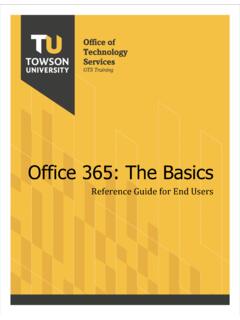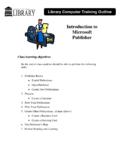Transcription of BACHELOR OF COMPUTER APPLICATIONS (BCA) Regular …
1 BACHELOR OF COMPUTER APPLICATIONS (BCA) RegularSyllabus and SCHEME OF EXAMINATION Ist , IInd, IIIrd YEAR(6 semesters) 2012-13 Period per week: 6 for each theory paper and 6 for each practical group in each of PaperMax. MarksPassMarksExamDurationExternal InternalSemester I 2012-13 BCA-101 COMPUTER & Programming Fundamentals8020353hrsBCA-102 PC Software8020353hrsBCA-103 Mathematics8020353hrsBCA-104 Logical Organization of COMPUTER -I8020353hrsBCA-105 Practical software Lab Based on paperBCA-102 Word, excel and powerpoint 80 20353hrsSemester IIBCA-106 C Programming8020353hrsBCA-107 Logical Organization of COMPUTER -II8020353hrsBCA-108 Mathematical Foundations of ComputerScience8020353hrsBCA-109 Structured System Analysis and Design8020353hrsBCA-110 Practical software Lab Based on paperBCA-106.
2 C Programming 80 20353hrsSemester III 2013-14 BCA-201 Introduction to Operating System8020353hrsBCA-202 DATA STRUCTURES I8020353hrsBCA-203 Introduction to database system8020353hrsBCA-204 Communication skills (English)8020353hrsBCA-205 Practical software Lab Based on paperBCA-202 & 203 using C Language and SQL80 20353hrsSemester IVBCA-206 WEB DESIGNING8020353hrsBCA-207 DATA STRUCTURES II8020353hrsBCA-208 Object Oriented Programming Using C++8020353hrsBCA-209 Software Engineering8020353hrsBCA-210 Practical software Lab Based on paper BCA-206 & 208, and C++ Programming 80 20353hrsSemester V 2014-15 BCA-301 Management information system8020353hrsBCA-302 COMPUTER Graphics8020353hrsBCA-303 Data Communication and Networking8020353hrsBCA-304 Visual Basic8020353hrsBCA-305 Practical software Lab Based on paper BCA-304 Visual Basic 80 20353hrsSemester VIBCA-306E-Commerce8020353hrsBCA-307 Object Technologies & Programming using Java8020353hrsBCA-308 Artificial Intelligence8020353hrsBCA-309 Introduction to.
3 Net8020353hrsBCA-310 Practical software Lab Based on paper BCA-307 & 309 using java & .net 80 20353hrsSyllabus of BCA I and II semester effective from 2012-13 BCA-101 : COMPUTER & PROGRAMMING FUNDAMENTALS External Marks: 80 Internal Marks: 20 Time: 3 hoursNote: Examiner will be required to set NINE questions in all. Question Number 1 will consist oftotal 8 parts (short-answer type questions) covering the entire syllabus and will carry 16 marks. Inaddition to the compulsory question there will be four units Unit-I to Unit-IV. Examiner will settwo questions from each Unit of the syllabus and each question will carry 16 marks. Student will berequired to attempt FIVE questions in all. Question Number 1 will be compulsory.
4 In addition tocompulsory question, student will have to attempt four more questions selecting one question fromeach Fundamentals: Generations of Computers, Definition, Block Diagram along withits components, characteristics & classification of computers, Limitations of Computers,Human-Being VS COMPUTER , APPLICATIONS of computers in various : Concept of primary & secondary memory, RAM, ROM, types of ROM, CacheMemory, flash memory, Secondary storage devices: Sequential & direct access devices tape, magnetic disk, optical disks CD, DVD, virtual hardware & software: I/O devices, definition of software, relationship betweenhardware and software, types of of operating system: Definition, functions of operating system, concept ofmultiprogramming, multitasking, multithreading, multiprocessing, time-sharing, real time,single-user & multi-user operating Virus: Definition, types of viruses, Characteristics of viruses, anti-virus Languages: Analogy with natural language, machine language, assembly language,high-level languages, forth generation languages, compiler, interpreter, assembler, Linker,Loader , characteristics of a good programming language, Planning the COMPUTER Program:Concept of problem solving, Problem definition, Program design, Debugging, Types oferrors in programming, programming concepts, Programming methodologies viz.
5 Top-down and bottom-up programming, Advantages and disadvantages of Structured of Networking: An introduction to COMPUTER networking, Network types (LAN,WAN, MAN), Network topologies, Modes of data transmission, Forms of datatransmission, Transmission channels(media), Introduction to internet and its uses, APPLICATIONS of internet, Hardware and Software requirements for internet, Intranet, APPLICATIONS of Nasib Singh: Computing Fundamentals and Programming in C, Khanna BooksPublishing Co., New E, Computing Fundamentals and C Programming, Tata McGraw , Peter, Introduction to COMPUTER , , Alexis & Leon, Mathews, Introduction to Computers, Leon Tech , V., Fundamentals of Computers, , B., COMPUTER Fundamentals, Architecture & Organization, New Age International(P) , Rajender Singh: Application of IT to Business, Ramesh Publishers, , Nasib Singh: Essentials of COMPUTER and Network Technology, Khanna BooksPublishing Co.
6 , New DelhiNote: Latest and additional good books may be suggested and added from time to : PC SOFTWAREE xternal Marks: 80 Internal Marks: 20 Time: 3 hoursNote: Examiner will be required to set NINE questions in all. Question Number 1 will consist oftotal 8 parts (short-answer type questions) covering the entire syllabus and will carry 16 marks. Inaddition to the compulsory question there will be four units Unit-I to Unit-IV. Examiner will settwo questions from each Unit of the syllabus and each question will carry 16 marks. Student will berequired to attempt FIVE questions in all. Question Number 1 will be compulsory. In addition tocompulsory question, student will have to attempt four more questions selecting one question fromeach - IMS-Windows: Operating system-Definition & functions, basics of Windows.
7 Basiccomponents of windows, icons, types of icons, taskbar, activating windows, using desktop,title bar, running APPLICATIONS , exploring COMPUTER , managing files and folders, copying andmoving files and folders. Control panel display properties, adding and removing softwareand hardware, setting date and time, screensaver and appearance. Using - IIDocumentation Using MS-Word - Introduction to word processing interface, Toolbars,Menus, Creating & Editing Document, Formatting Document, Finding and replacing text,Format painter, Header and footer, Drop cap, Auto-text, Autocorrect, Spelling andGrammar Tool, Document Dictionary, Page Formatting, Bookmark, Previewing andprinting document, Advance Features of MS-Word-Mail Merge, Macros, Tables, FileManagement, Printing, Styles, linking and embedding object, - IIIE lectronic Spread Sheet using MS- excel - Introduction to MS- excel , Cell, cell address,Creating & Editing Worksheet, Formatting and Essential Operations, Moving and copyingdata in excel .
8 Header and footer, Formulas and Functions, Charts, Cell referencing, Pagesetup, Macros, Advance features of MS- excel -Pivot table & Pivot Chart, Linking andConsolidation, Database Management using excel -Sorting, Filtering, Validation, What ifanalysis with Goal Seek, Conditional - IVPresentation using MS- powerpoint : Presentations, Creating, Manipulating & EnhancingSlides, Organizational Charts, excel Charts, Word Art, Layering art Objects, Animations andSounds, Inserting Animated Pictures or Accessing through Object, Inserting RecordedSound Effect or In-Built Sound Office Complete Reference BPB Microsoft Office Russell A. Stultz BPB , G Marquis (1999). Microsoft Office 2000: Professional Edition.
9 , D (2001). Microsoft Office XP Fast and Easy. , S L and Kelly, J (2002). Office XP: The Complete Reference. Tata : Latest and additional good books may be suggested and added from time to : MATHEMATICSE xternal Marks: 80 Internal Marks: 20 Time: 3 hoursNote: Examiner will be required to set NINE questions in all. Question Number 1 will consist oftotal 8 parts (short-answer type questions) covering the entire syllabus and will carry 16 marks. Inaddition to the compulsory question there will be four units Unit-I to Unit-IV. Examiner will settwo questions from each Unit of the syllabus and each question will carry 16 marks. Student will berequired to attempt FIVE questions in all. Question Number 1 will be compulsory.
10 In addition tocompulsory question, student will have to attempt four more questions selecting one question fromeach ISETS:Sets, Subsets, Equal Sets Universal Sets, Finite and Infinite Sets, Operation on Sets,Union, Intersection and Complements of Sets, Cartesian Product, Cardinality of Set, : Definition, Minors, Cofactors, Properties of Determinants, Applicationsof determinants in finding area of triangle, Solving a system of linear : Definition, Types of Matrices, Addition, Subtraction, Scalar Multiplicationand Multiplication of Matrices, Adjoint, Inverse, solving system of linear equation Cramer IIRELATIONS AND FUNCTIONS:Properties of Relations, Equivalence Relation,Partial Order Relation Function: Domain and Range, Onto, Into and One to OneFunctions, Composite and Inverse & CONTINUITY: Limit at a Point, Properties of Limit, Computation of Limits ofVarious Types of Functions, Continuity of a function at a Point, Continuity Over an Interval,Sum, product and quotient of continuous functions, Intermediate Value Theorem, Type IIIDIFFERENTIATION: Derivative of a function, Derivatives of Sum, Differences, Product& Quotient of functions, Derivatives of polynomial, trigonometric, exponential, logarithmic,inverse trigonometric and implicit functions, Logarithmic Differentiation, Chain Rule anddifferentiation by IVINTEGRATION.








